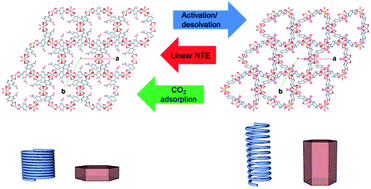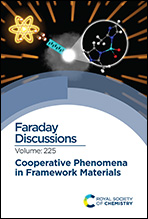Multi-stimulus linear negative expansion of a breathing M(O2CR)4-node MOF†
Abstract
The metal–organic framework (Me2NH2)2[Cd(NO2BDC)2] (SHF-81) comprises flattened tetrahedral Cd(O2CR)42− nodes, in which Cd(II) centres are linked via NO2BDC2− ligands (2-nitrobenzene-1,4-dicarboxylate) to give a doubly interpenetrated anionic network, with charge balanced by two Me2NH2+ cations per Cd centre resident in the pores. The study establishes that this is a twinned α-quartz-type structure (trigonal, space group P3x21, x = 1 or 2), although very close to the higher symmetry β-quartz arrangement (hexagonal, P6x22, x = 2 or 4) in its as-synthesised solvated form [Cd(NO2BDC)2]·2DMF·0.5H2O (SHF-81-DMF). The activated MOF exhibits very little N2 uptake at 77 K, but shows significant CO2 uptake at 273–298 K with an isosteric enthalpy of adsorption (ΔHads) at zero coverage of −27.4 kJ mol−1 determined for the MOF directly activated from SHF-81-DMF. A series of in situ diffraction experiments, both single-crystal X-ray diffraction (SCXRD) and powder X-ray diffraction (PXRD), reveal that the MOF is flexible and exhibits breathing behaviour with observed changes as large as 12% in the a- and b-axes (|Δa|, |Δb| < 1.8 Å) and 5.5% in the c-axis (|Δc| < 0.7 Å). Both the solvated SHF-81-DMF and activated/desolvated SHF-81 forms of the MOF exhibit linear negative thermal expansion (NTE), in which pores that run parallel to the c-axis expand in diameter (a- and b-axis) while contracting in length (c-axis) upon increasing temperature. Adsorption of CO2 gas at 298 K also results in linear negative expansion (Δa, Δb > 0; Δc < 0; ΔV > 0). The largest change in dimensions is observed during activation/desolvation from SHF-81-DMF to SHF-81 (Δa, Δb < 0; Δc > 0; ΔV < 0). Collectively the nine in situ diffraction experiments conducted suggest the breathing behaviour is continuous, although individual desolvation and adsorption experiments do not rule out the possibility of a gating or step at intermediate geometries that is coupled with continuous dynamic behaviour towards the extremities of the breathing amplitude.

- This article is part of the themed collection: Cooperative phenomena in framework materials


 Please wait while we load your content...
Please wait while we load your content...